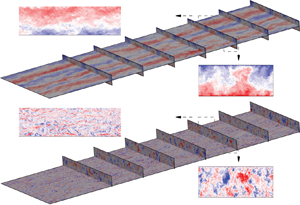Article contents
Wall-resolved and wall-modelled large-eddy simulation of plane Couette flow
Published online by Cambridge University Press: 21 January 2022
Abstract

We describe wall-resolved and wall-modelled large-eddy simulation (LES) of plane Couette (PC) flow. Subgrid-scale (SGS) motion is represented using the stretched-spiral vortex SGS model and the virtual wall model is employed for wall-modelled LES. Cases studied include direct numerical simulation (DNS) at friction Reynolds numbers  $Re_\tau = 220$, wall-resolved LES at
$Re_\tau = 220$, wall-resolved LES at  $Re_\tau \sim 500\text {--}3600$ and wall-modelled LES at
$Re_\tau \sim 500\text {--}3600$ and wall-modelled LES at  $Re_\tau \sim 3600\text {--}2.8\times 10^{5}$. All LES performed show the presence of approximately spanwise periodic sets of streamwise rolls. Averaged (including spanwise) wall-normal profiles of the mean streamwise velocity show a consistent log region across all Reynolds numbers. Two distinct measures of turbulent intensity are explored, one of which recognizes the roll structure and one that does not. The spanwise variation of turbulence flow metrics is investigated. Mean streamwise velocity profiles show substantial spanwise variation but collapse well when normalized by local skin-friction velocities. Similar collapse is found for streamwise turbulent intensities. For all present LES, the mean skin-friction variation with the plate Reynolds number is found to match a simple analytical form (Pirozzoli et al., J. Fluid Mech., vol. 758, 2014, pp. 327–343) while the scaled centre-plane, mean-velocity gradient exhibits an inverse ProductLog dependence. Both the mean-flow roll energy and circulation, scaled with outer variables, decrease monotonically for
$Re_\tau \sim 3600\text {--}2.8\times 10^{5}$. All LES performed show the presence of approximately spanwise periodic sets of streamwise rolls. Averaged (including spanwise) wall-normal profiles of the mean streamwise velocity show a consistent log region across all Reynolds numbers. Two distinct measures of turbulent intensity are explored, one of which recognizes the roll structure and one that does not. The spanwise variation of turbulence flow metrics is investigated. Mean streamwise velocity profiles show substantial spanwise variation but collapse well when normalized by local skin-friction velocities. Similar collapse is found for streamwise turbulent intensities. For all present LES, the mean skin-friction variation with the plate Reynolds number is found to match a simple analytical form (Pirozzoli et al., J. Fluid Mech., vol. 758, 2014, pp. 327–343) while the scaled centre-plane, mean-velocity gradient exhibits an inverse ProductLog dependence. Both the mean-flow roll energy and circulation, scaled with outer variables, decrease monotonically for  $Re_\tau \gtrsim 500$. At lower
$Re_\tau \gtrsim 500$. At lower  $Re_\tau$, the mean streamwise zero-velocity line follows a wavy form in the spanwise direction, while at our larger
$Re_\tau$, the mean streamwise zero-velocity line follows a wavy form in the spanwise direction, while at our larger  $Re_\tau$, a mushroom shape emerges which could potentially enhance local momentum transport in the spanwise direction and be responsible for the weakening of the spanwise rolls.
$Re_\tau$, a mushroom shape emerges which could potentially enhance local momentum transport in the spanwise direction and be responsible for the weakening of the spanwise rolls.
JFM classification
- Type
- JFM Papers
- Information
- Copyright
- © The Author(s), 2022. Published by Cambridge University Press
References
REFERENCES
- 8
- Cited by



